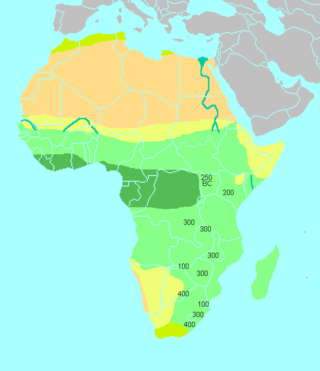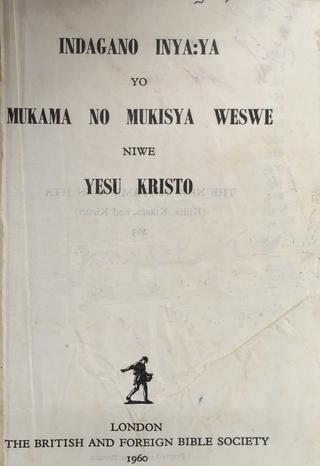Notes
- ↑ Bantu Classification Archived 2012-06-24 at the Wayback Machine , Ehret, 2009.
| Official language | |
|---|---|
| National languages | |
| Non-official | |
| | This Bantu language-related article is a stub. You can help Wikipedia by expanding it. |
| Ngambwe | |
|---|---|
| Olungambwe | |
| Native to | Angola |
| Language codes | |
| ISO 639-3 | None (mis) |
| Glottolog | None |
Ngambwe is a Bantu language of Angola. Until perhaps Anita Pfouts (2003), it was considered a dialect of Nyaneka. [1]

The Bantu languages are a large family of languages spoken by the Bantu peoples of Central, Southern, Eastern Africa and Southeast Africa. They form the largest branch of the Southern Bantoid languages.

Niger–Congo is a hypothetical language family spoken over the majority of sub-Saharan Africa. It unites the Mande languages, the Atlantic-Congo languages, and possibly several smaller groups of languages that are difficult to classify. If valid, Niger-Congo would be the world's largest in terms of member languages, the third-largest in terms of speakers, and Africa's largest in terms of geographical area. It is generally considered to be the world's largest language family in terms of the number of distinct languages, just ahead of Austronesian, although this is complicated by the ambiguity about what constitutes a distinct language; the number of named Niger–Congo languages listed by Ethnologue is 1,540.
The Tutsi, or Abatutsi, are an ethnic group of the African Great Lakes region. They are a Bantu-speaking ethnic group and the second largest of three main ethnic groups in Rwanda and Burundi.

The Bantu expansion is a hypothesis about the history of the major series of migrations of the original Proto-Bantu-speaking group, which spread from an original nucleus around Central Africa across much of sub-Saharan Africa. In the process, the Proto-Bantu-speaking settlers displaced or absorbed pre-existing hunter-gatherer and pastoralist groups that they encountered.

Candomblé Bantu is one of the major branches (nations) of the Candomblé religious belief system. It developed in the Portuguese Empire among Kongo and Mbundu slaves who spoke Kikongo and Kimbundu languages. The supreme and creative god is Nzambi or Nzambi a Mpungu. Below him are the Jinkisi or Minkisi, deities of Bantu mythology. These deities resemble Olorun and the other orishas of the Yoruba religion. Minkisi is a Kongo language term: it is the plural of Nkisi, meaning "receptacle". Akixi comes from the Kimbundu language term Mukixi.

Southern Bantoid is a branch of the Bantoid language family. It consists of the Bantu languages along with several small branches and isolates of eastern Nigeria and west-central Cameroon. Since the Bantu languages are spoken across most of Sub-Saharan Africa, Southern Bantoid comprises 643 languages as counted by Ethnologue, though many of these are mutually intelligible.
Gweno is a Bantu language spoken in the North Pare Mountains in the Kilimanjaro Region of Tanzania. The people known as the Gweno are a Chaga ethnic and linguistic group. Since the Chaga people are Bantu speakers, the adopted language contains dialects similar to that of the Kenyan language Kamba. Gweno shares about 54% to 56% of its vocabulary with other Chaga dialects and 46% with Taita dialects. However, a large percentage of its vocabulary is not seen in the other dialects. Also at the start of the 11th century, the Chaga people descended and migrated from the Bantu group in which they migrated to the foothills of mount Kilimanjaro. The Gweno language is today spoken mostly by older adults, with younger generations having shifted to Asu and Swahili. Ethnologue considers Gweno to be moribund; the language is not being passed down because children have not been exposed to Gweno since the 1970s. The generational shift from Gweno to either Asu or Swahili has certainly created shifts in dialect, however Gweno speakers do not see this as a threat.
Myene is a cluster of closely related Bantu varieties spoken in Gabon by about 46,000 people. It is perhaps the most divergent of the Narrow Bantu languages, though Nurse & Philippson (2003) place it in with the Tsogo languages (B.30). The more distinctive varieties are Mpongwe (Pongoué), Galwa (Galloa), and Nkomi.
The Somali Bantus are a Bantu origin ethnic minority group in Somalia who primarily reside in the southern part of the country, primarily near the Jubba and Shabelle rivers. The Somali Bantus are descendants of enslaved peoples from various Bantu ethnic groups from Southeast Africa, particularly from Mozambique, Malawi, and Tanzania. The East African slave trade was not eliminated until the early parts of the 20th century.
Tswa (Xitswa) is a South-Eastern Bantu language in Southern Mozambique. Its closest relatives are Ronga and Tsonga, the three forming the Tswa–Ronga family of languages.
Yao is a Bantu language in Africa with approximately two million speakers in Malawi, and half a million each in Tanzania and Mozambique. There are also some speakers in Zambia. In Malawi, the main dialect is Mangochi, mostly spoken around Lake Malawi. In Mozambique, the main dialects are Makale and Massaninga. The language has also gone by several other names in English, including chiYao or ciYao, Achawa, Adsawa, Adsoa, Ajawa, Ayawa, Ayo, Ayao, Djao, Haiao, Hiao, Hyao, Jao, Veiao, and waJao.
Bantu may refer to:
Mbugwe or Mbuwe (Kimbugwe) is a Bantu language of spoken by the Mbugwe people of Lake Manyara in the Manyara Region of Central Tanzania. Mbugwe is estimated to be spoken by some 34,000 people.

Bantu mythology is the system of beliefs and legends of the Bantu people of Africa. Although Bantu peoples account for several hundred different ethnic groups, there is a high degree of homogeneity in Bantu cultures and customs, just as in Bantu languages.
The Zigula or Zigua language, Chizigua, is a Bantu language of Tanzania and Somalia, where the Mushunguli dialect is spoken.
The Nen language, Tunen (Banen), is a Bantu language of Cameroon. Maho (2009) considers Aling'a to be a distinct language. Unlike all other Bantu languages, Nen has an SOV word order rather than the standard Bantu SVO word order.

Jita is a Bantu language of Tanzania, spoken on the southeastern shore of Lake Victoria/Nyanza and on the island of Ukerewe.

The Bantu peoples, or Bantu, are an ethnolinguistic grouping of approximately 400 distinct ethnic groups who speak Bantu languages. They are native to 24 countries spread over a vast area from Central Africa to Southeast Africa and into Southern Africa. There are several hundred Bantu languages. Depending on the definition of "language" or "dialect", it is estimated that there are between 440 and 680 distinct languages. The total number of speakers is in the hundreds of millions, ranging at roughly 350 million in the mid-2010s. About 60 million speakers (2015), divided into some 200 ethnic or tribal groups, are found in the Democratic Republic of the Congo alone.

Slavery in Somalia existed as a part of the East African slave trade. To meet the demand for menial labor, Bantus from southeastern Africa slaves were exported from the Zanzibar and were sold in cumulatively large numbers over the centuries to customers in East Africa and other areas in Northeast Africa and Asia. People captured locally during wars and raids were also sometimes captured by Somalis and Ethiopians, Oromo, Amhara and Nilotic origin. However, the perception, capture, treatment and duties of both groups of slaves differed markedly, with Oromo favored because Oromo subjects were not viewed as linguistically and culturally different by their Somali owners.
Nzadi is a Bantu language spoken in the Democratic Republic of the Congo, "from Kwamuntu to Ilebo along the north side of the Kasai River in Bandundu Province." The number of speakers of Nzadi is not known, but is estimated to be in the thousands. The Nzadi language has three dialects, Ngiemba, Lensibun, and Ndzé Ntaa.